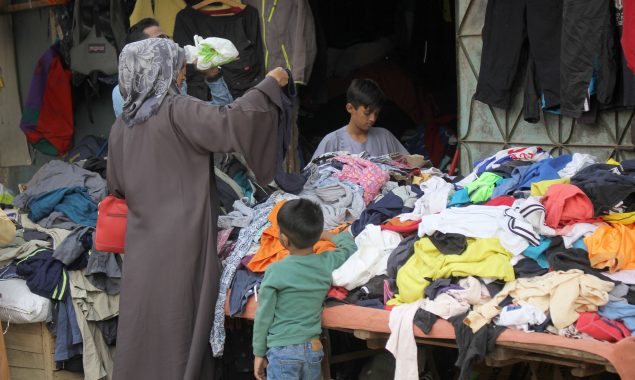
A woman looks at used clothes at a stall in Saddar. Photo: Athar Khan/Bol News
KARACHI: Karachi’s consumers are flocking to markets selling second-hand clothes for what is expected to be a bumper year for the country’s largest city.
Reportedly, the sellers at these markets had anticipated that even those who were previously not using second-hand clothes will now turn toward used clothing due to rising inflation and unprecedented price hike.
Keeping in view the situation, local importers have doubled their orders of used clothing items for the winter season.
The importers told Bol News that consumers of middle-income backgrounds were ‘fashion-conscious’, yet they were left with no choice but to opt for second-hand winter wear due to devaluation of the rupee.
As a result, neither locally produced woollies nor leather jackets could compete with the price or quality of used clothes imported from the US and European countries.
Even locally manufactured pullovers and sweaters had reportedly become expensive due to which even well-to-do consumers also reconsidered purchasing from any top-of-the-line local brand’s outlets.
The second-hand clothing market, located in the Lighthouse area on MA Jinnah Road had been around for decades and was once regarded as one of the biggest used clothes markets in Asia.
However, after the removal of more than 3,000 illegally constructed shops, this status had definitely been changed.
The shops that were shut down were eventually shifted to various neighbourhoods in the city which include Malir, Sohrab Goth and Teen Hatti.
The price and quality of the clothes differ from area to area. On the other hand, less-worn clothes of known brands were sold for better prices.
Price differential
Jeans were available for Rs200 in the used clothes market while they were priced at around Rs900 in Zainab Market.
Cotton T-shirts of local brands were available for Rs1,500 in local malls. Similarly, a better quality used T-shirt was available for Rs100. A locally manufactured sweater was available for Rs4,500 whereas an imported used sweater was priced at Rs250. So the price difference was the major attraction for buyers apart from the quality of imported articles.
Pakistan imported 186,299 metric tonnes of used clothes between July-August of fiscal year 2021-22, which was a drastic rise of 283 per cent compared to last year. Importers added that second-hand clothing items were currently meeting around 30pc of winter wear requirements of the country’s lowest stratum.
The demand was bound to increase as more and more people were expected to flock to the markets selling second-hand clothes due to the unprecedented price hike.
However, despite the unprecedented flow in the market, this winter season was going to be tough in terms of living standards for the average local resident owing to the devaluation of the rupee against the US dollar. This devaluation in rupee had increased the cost of imported used winter clothes whereas duties and heavy taxes had further made the situation worse for the poor segment of society.
Due to the inflation and taxation situation, the importers requested, in a letter written to Adviser to the Prime Minister on Commerce and Investment Abdul Razak Dawood, for the curtailment of duties and taxes on imports of used clothing to bring down the increased cost.
However, the PM’s adviser had not responded to the importers.
Normally, second-hand articles including blankets, jackets, shoes and other casual wear were being imported for meeting the requirements of Karachi’s low-income segment, around 30pc of which cannot afford new items due to price difference between new and old items.
This year, another 30pc of middle-income consumers were expected to buy used items reportedly because they were unable to cope with the financial stress. As such the importers had doubled the order.
Harsh winter
According to a report, Karachi has more than 600 slums. Around 60-65pc of Karachi’s population lives in these slums and more than half of them cannot afford even a single sweater for the season. They had to rely on charity or survive the winter season without the appropriate clothing.
A number of welfare organisations usually step in to provide free warm clothing for the urban poor.
In this regard, welfare organisations act as a ray of hope for those unable to afford basic winter clothing. Reportedly, charity organisations with the help of philanthropists collect as many warm clothes, quilts, blankets and shawls as possible so that they can be delivered to those in need in a timely manner.
With the advent of winter, brisk trading in used clothes begins in Karachi to cater for the demands of the populace.
The United States and Italy were reportedly among the leading exporters of used clothing globally with export values of $575.5 million and $118.6m respectively.
Meanwhile, Uganda imported $72.3m of used clothes and Pakistan imported $239.5m worth of used clothing items, making the two countries the leading importers of second-hand clothing.
Catch all the Pakistan News, Breaking News Event and Latest News Updates on The BOL News
Download The BOL News App to get the Daily News Update & Follow us on Google News.




